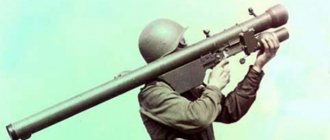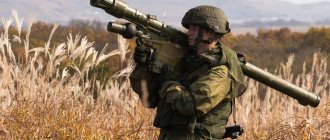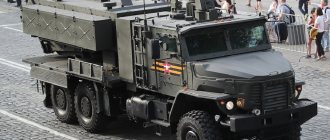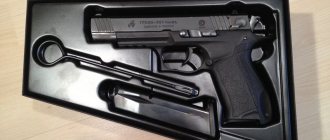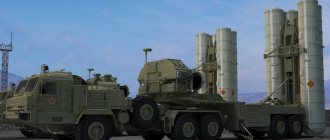In ancient times, when planes were not so fast, they were built from ordinary wood, and the planes were armed with standard machine guns - infantry could easily defend themselves against them with rifles. But time passed, technology changed, and by World War II, aircraft became faster, flew much higher and attacked from a distance exceeding the effective range of infantry weapons.
The emergence and development of homing guided missiles helped change this situation. In America, the Stinger is considered one of the most popular man-portable anti-aircraft missile systems; in Russia, the most famous modern representative of this weapon is the Igla MANPADS.
History of creation
In the 60s, the Soviet Union adopted the Strela-2 MANPADS (essentially a direct copy of the American Red Eye complex). Deliveries of Strels to friendly regimes and “developing countries” began immediately. Over the next decade, she showed fairly high fighting qualities. But the Strela also had disadvantages, which were, in principle, characteristic of all early anti-aircraft missiles.
The infrared homing head did not have sufficient sensitivity and could not capture a target following, for example, a collision course. They also protected against MANPADS by such simple methods as deflecting the exhaust of helicopter engines upward.
The task to develop a new “individual” anti-aircraft missile system with enhanced combat qualities was received in 1971, and ten years later it entered service.
The new MANPADS was named “Igla”.
Application experience
The armies of more than four dozen countries are armed with the Igla anti-aircraft man-portable air defense system. Its use by Iraqi troops in 1991 caused the loss of several aircraft to the coalition air force, which demonstrated the high effectiveness of this type of Russian weapon even in conditions of almost complete suppression of air defense systems and air supremacy of the attacking side. Over the past two decades, many armed conflicts and wars have arisen in different regions of the planet. In most of them, one side or another used Igla MANPADS. Photos of militants and government soldiers with the characteristic "pipes", as well as damaged and destroyed aircraft, clearly illustrate the lethal power of this relatively small air defense weapon.
In post-Soviet history, the popularity of the Needle can only be rivaled by the famous Kalashnikov. We know about the last major contract for the supply of a large batch of these complexes for the Malaysian armed forces. The system's design continues to be improved, which has led to an increase in the combat use radius of the Igla of the Super modification to six kilometers. These MANPADS, as well as new, still secret models, will completely re-equip the Russian army in the near future.
Description of design
The most advanced modification of the Igla complex is Igla-S; this MANPADS has the highest tactical and technical characteristics. It was created as a result of a deep modernization of the 9K38 Igla MANPADS. This missile system is capable of countering not only enemy aircraft and helicopters, but also shooting down its drones and cruise missiles. The probability of hitting targets is 0.8-0.9.
Experts believe that the probability of hitting an F-16-type air target in the forward hemisphere is approximately 50%, taking into account the enemy’s use of all available active and passive interference and its intensive maneuvering.
The 9K338 Igla-S complex consists of a 9M342 missile in the launch tube and a launch mechanism, as well as a Mowgli-2 night vision device. The complex also includes means of its maintenance: a mobile control point and test equipment.
Compared to the base model, the Igla-S MANPADS has a greater destruction range (it has increased to 6 km) and increased warhead power (both in terms of explosives and the number of fragments). Despite this, the weight of the missile system remained virtually unchanged. In addition, the missile has become even more noise-resistant, which allows it to hit even well-protected targets.
The maximum flight altitude of an air target is 3.5 km. Its speed can reach 340 m/s. The weight of the complex is 19 kg.
The homing head of the GSN 9E435 missile has two channels for receiving incoming signals, which allows it to carry out effective selection and separate false targets from real ones. When approaching the target, the missile deviates from the guidance point (that is, from the nozzle) and hits the central part of the aircraft, which is much more vulnerable. In terms of vibration and shock resistance, the 9M342 missile is significantly superior to its predecessors.
In addition, for the first time, a non-contact fuse was installed in the missile, which ensures detonation at a short distance from the target, causing more serious damage to it. The issue of interaction between contact and non-contact fuses was also resolved. Moreover, with a contact detonation, the explosion does not occur immediately, but after a certain time, after the missile warhead penetrates the skin of the target aircraft. This significantly increases the efficiency of detonation.
The fuel used in the Igla-S MANPADS missile has high detonation properties, which further increases the missile’s combat effectiveness, especially when used on a collision course. Immediately after the missile takes off, the powder engine starts working, which directs the missile defense system to the lead point. All this happens without any human intervention.
It is very important to install a night vision device on the Igla-S MANPADS, which allows you to use this weapon at any time of the day. Modern aviation is increasingly making night raids, so such a device significantly increases the capabilities of the anti-aircraft complex. Using the Mowgli NVG, the shooter can aim and track a target without any problems.
When we talk about Igla MANPADS, we mean a whole family of man-portable missile systems. Despite the fact that modification “C” is the most modern and advanced, the army is armed with thousands of complexes of earlier modifications produced back in the Soviet period.
The dimensions of the Igla-S modification make it possible to fire missiles of older modifications. Moreover, the 9M342 missile can be used by the Igla and Igla-1 complexes. Mounting the Mowgli night vision device allows you to install this device on complexes of earlier modifications. The use of the Igla-S modification does not require serious retraining from military personnel who have previously dealt with Igla or Igla-1.
The Igla MANPADS is equipped with a reliable friend-or-foe identification system, which guarantees blocking of a missile launch against its own aircraft or helicopters.
The complex is able to operate effectively in any conditions: at extremely high and low temperatures, in conditions of high humidity, during heavy rainfall, and even after immersion in water (0.5 meters for 30 minutes). The missile system in the package is not afraid of a fall from a height of two meters, strong vibration and numerous mechanical shocks.
To ensure the firing of two anti-aircraft missiles at once, the Dzhigit launcher was created. It is equipped with an external preliminary determination system (“friend or foe”), self-diagnostics and maintenance tools. The shooter is in a swivel chair, with missile launch tubes to the left and right of him. Targeting is done manually. Salvo firing increases the probability of hitting an air target by 1.5 times.
Background[ | ]
Main article: Anti-aircraft grenade launcher
The immediate predecessors of MANPADS were anti-aircraft grenade launchers, developed primarily as a means of covering troops and designed to destroy low-flying aircraft in takeoff/landing, dive or hover modes. The striking elements of this kind of weapon were feathered or unfinned unguided rockets, and the required probability of destruction was achieved in a phased manner (with an interval of 0.1 to 0.8 seconds - German MANPADS " Luftfaust
"model 1944-1945) or a one-time salvo launch (MANPADS "
Kolos
", 1966-1968).
Performance characteristics
Let's compare the main indicators of the main version of the Igla, as well as its simplified version, and the famous American MANPADS "Stinger", which also appeared in service in the 1980s.
| 9K310 "Igla-1" | 9K38 "Igla" | FIM-92C “Stinger” | |
| Total weight, kg | 39 | 39 | 42 |
| Weight of warhead, kg | 1,1 | 1,1 | 3 |
| Maximum range, km | 5 | 5,2 | 4,5 |
| Maximum rocket speed, km/h | 2160 | 2052 | 2700 |
If you believe these indicators, then at the time of its appearance the Stinger was distinguished by high power and was a faster missile. But it is worth noting that American engineers did not provide for fire control via an electronic tablet. The Stinger's homing head was also equipped with a system to counteract heat traps, but, basically, it was achieved by complex information processing systems.
In terms of combat, MANPADS can be considered equivalent - although no one has yet succeeded in sparking a civil war or turning the tide of a military campaign with the help of one Stinger.
It is noteworthy that the ease of operation and adoption of both American and domestic MANPADS stemmed from the fact that they were initially considered as a means of conducting special operations and guerrilla warfare.
The British Blowpile MANPADS demonstrated the opposite approach. It was superior to all analogues in terms of noise immunity and was all-weather. But he had a more complex and lengthy training program for rocket scientists, who must have an appropriate level of qualifications and constantly maintain it at the proper level.
The portable air defense system “Igla” became an important achievement of the domestic industry and rightfully enjoyed high popularity (“Igla” was chosen by the majority of countries that did not buy the “Stinger”).
But at present, this development is becoming obsolete.
Since 2014, the new Verba MANPADS entered service. According to experts, this system is a continuation of the development of solutions that were incorporated in Igla, so this is another confirmation that back in the 80s the correct qualities were embedded in the complex. And there are no plans to discontinue Igloo-S.
History[ | ]
Training firing from MANPADS Missile launch from MANPADS
The development of MANPADS in the modern sense of the term began in the 1950s, simultaneously with experiments on grenade launchers and rocket launchers with unguided anti-aircraft missiles, as well as work to improve, modernize and extend the service life of anti-aircraft machine guns . For the first time, the idea of creating an individual air defense system with a recoilless type launcher (like the most serial American grenade launcher of the Second World War, the “bazooka”), allowing firing guided missiles at air targets from the shoulder to equip infantrymen with it, arose in 1950 along with the beginning of the Korean War. war among Californian rocket engineers led by Karel Bossart. But then, a group of scientists had reasonable doubts about the prospects for the instrumental implementation of their plan on the existing production and technical base, with the existing rocket technology and the existing level of development of guided missile weapons guidance systems[4]. In 1955, taking into account the accumulated experience and developments gained, they returned to their idea, they initiated internal corporate research work with a feasibility study for the fundamental possibility of creating and organizing mass production of a light man-portable anti-aircraft missile system, [K 2] providing the possibility destruction of low-flying air targets with a probability higher than that specified for existing tactical anti-aircraft weapons (otherwise the idea would be impractical) and unpretentious enough in operation for use by infantrymen in a combat zone[5]. The research they carried out with a feasibility study confirmed the fundamental feasibility of the plan (therefore, the winter of 1955-56 can be conditionally considered the date of birth of the modern MANPADS) and already in January 1956, the engineering and technical staff of the company were given a tactical and technical task for the development and creation of a functional dimensional mock-up missiles called "Redai" (" red eye"
"or "
red-eyed
" for the infrared homing head of a characteristic shape in the head of the missile).[5]
The first mention of the Redeye MANPADS in the open press dates back to mid-May 1957, when representatives of the management of the Convair rocket-building division issued a press statement announcing that they had developed a new type of infantry weapon with a homing missile, light enough to be operated by one person [ 6]. In May 1958, USMC personnel launched unguided mass-dimensional light-noise simulators of missiles to establish the risk factors during their launch for humans and the negative impact on the tactical situation as a whole (unmasking factors, fire hazard due to the spread of the jet stream, smoke and dust from the firing position, loss of target visibility, etc.) and already a month later, at the end of June, test launches of missiles with an infrared seeker began [7]. The complex was presented to the attention of the press in mid-November 1958, [8] and in August 1959 it was presented in the exhibition pavilion at annual symposium of the Association of the US Army, where, in addition to important officials, foreign guests were invited[9]. Information about early models of man-portable anti-aircraft missile systems in chronological order (by start date of work)
| Name | Year | Chief designer | Head organization | Subdivision | Location | Rocket type | Comments | |||
| Redeye | 19550000 1955 | Karel Bossart | General Dynamics Corp. | Convair Div. | Pomona, California | homing | did not enter service[5] | |||
| Lancer | 19570000 1957 | Heinz Fornoff | Sperry Gyroscope Co. | Missile Flight Control Dept. | Garden City, New York | controlled | did not go beyond the limits of experiments[10] | |||
| SLAM | 19570000 1957 | Norman Francis Parker | North American Aviation, Inc. | Autonetics Div. | Downey, California | homing | did not go beyond the limits of experiments[10] | |||
| not assigned | 19570000 1957 | Ludwig Bölkow | Bolkow-Entwicklungen KG | Flugkörper-Abteilung | Stuttgart, Baden-Württemberg | unknown | did not go beyond the limits of experiments[11] | |||
| Harpy | 19580000 1958 | Rodney Evert Gage | Audio-Sonics Corp. | Canoga Park, California | homing | did not go beyond the limits of experiments[12] | ||||
| not assigned | 19590000 1959 | Willis Hawkins | Lockheed Aircraft Corp. | Missile Systems Div. | Van Nuys, California | unknown | did not go beyond the limits of experiments[13] | |||
| Strela-2 | 19600000 1960 | B. I. Shavyrin | Special design bureau GKOT | Kolomna, Moscow region, RSFSR | homing | adopted for service in 1968[14] | ||||
| not assigned | 19600000 1960 | Emil Stauff | Nord Aviation SA | Section des Engins Spéciaux | Chatillon-sous-Bagneux, Ile-de-France | unknown | did not go beyond the limits of experiments[15] | |||
| Thunderstick | 19600000 1960 | Alfred Zeringer | American Rocket Co. | Taylor, Michigan | uncontrollable | did not go beyond the limits of experiments[12] | ||||
| Blowpipe | 19620000 1962 | Hugh Graham Conway | Short Brothers & Harland Ltd | Guided Weapons Div. | Castlereagh, Down, Northern Ireland | controlled | entered service in 1972 | |||
| Redeye Block I | 19640000 1964 | Karel Bossart | General Dynamics Corp. | Convair Div. | Pomona, California | homing | adopted in 1968[5] | |||
| Dagger | 19640000 1964 | Richard Sutton Ransom | Short Brothers & Harland Ltd | Guided Weapons Div. | Castlereagh, Down, Northern Ireland | homing | did not enter service[16] | |||
| Ear | 19660000 1966 | A. G. Novozhilov | Mechanical Engineering Design Bureau MOP | Kolomna, Moscow region, RSFSR | uncontrollable | did not enter service[17] | ||||
| Redeye 2 | 19670000 1967 | Karel Bossart | General Dynamics Corp. | Convair Div. | Pomona, California | homing | did not enter service[5] | |||
| Strela-2M | 19680000 1968 | S.P. Invincible | Mechanical Engineering Design Bureau MOP | Kolomna, Moscow region, RSFSR | homing | adopted in 1970[14] | ||||
The placement of federal orders in the United States, including orders for R&D in the field of weapons and military equipment, is carried out on a competitive basis, the winner is determined in the competition, therefore in 1957, before the start of the field testing stage, the Redeye MANPADS competed with similar complexes from rocket manufacturing and "North American Aviation", the first example was called "Lancer", the second was called "Slam" (a backronym for " shoulder-launched anti-aircraft missile
").[5][7] The main requirements that the army command imposed on the control samples of the three competing companies were as follows:[18]
- The combat weight of the complex should ensure its normal transportability on foot.
- The diameter of the rocket should ensure ease of mass production of fuselage elements and compartments on existing metalworking machines and stamping and pressing equipment without recalibrating it (a standard 70-mm unguided aircraft rocket was taken as a sample)
- The overall dimensions of the complex must correspond to the volume of internal space of existing serial units of vehicles and armored vehicles (70-mm NAR per sample).
- The complex's guidance system must ensure reliable engagement of low-flying targets, both manned and unmanned fixed-wing aircraft (airplanes) and rotary-wing aircraft (helicopters).
- The missile in a sealed launch tube must be a unitary munition, supplied loaded in factory configuration and ready for combat use.
- There is no need for routine maintenance and minimal requirements for inspection of launch tubes with missiles stored capped in warehouses.
- An extremely short training course for an anti-aircraft gunner.
- Safety for the shooter at the time of launch.
- Easy to use.
SAM "Lancer" ( Lancer
) was carried disassembled by a crew of two people, further operation after deployment to the firing position and installation of the launch tube with the missile on the guide could be carried out by the shooter alone, the missile was launched from a machine installed on the ground or mounted on a vehicle.
It corresponded to the definition of a limited-portable air defense system; as a means of ensuring mobility, it required a unit of motor transport, such as a standard light army off-road vehicle such as a half-ton jeep. Based on the results of the assessment, it was recognized as not meeting the requirements of an individual weapon (since it could not be properly transported and serviced alone) and many times exceeding the requirements for the maximum permissible combat weight of weapons (subsequently, in December 1958, the Sperry would again compete with the Convair , when he brings to the attention of the army command an improved version of the Lancer against the self-propelled modification of the Redeye, which will be presented among other models of self-propelled air defense systems as part of the Mohler project). The Slam MANPADS ( SLAM
) was carried and maintained by one soldier, the missile was launched from the shoulder and in its design it was in many ways identical to the Redeye. When assembled, the complex with the rocket weighed about 23 kg (that is, 2.5 times more than the control sample of the main competitor). Further development was rejected by the military command due to exceeding the maximum permissible combat weight of the weapon. Comparative analysis and evaluation of functional mock-ups and accompanying technical documentation of the three above-mentioned complexes were carried out by an expert commission of officers of the US Army Missile Command chaired by Francis Duval until January 17, 1958, when Redeye was recognized as the winner of the competition. After representatives of the top management of North American Aviation appealed this decision to higher authorities (since they considered the advantages of the latter to be not so obvious), specialists from the US Army Artillery Technical Committee were instructed to conduct an in-depth comparative analysis of the technical qualities of Slam and “Redai”, which was carried out until April 1958 and confirmed the commission’s conclusions regarding the superiority of the latter[10].
A little later than the publication of data on the Redeye MANPADS in the press, several more portable models of anti-aircraft weapons (Harpy and Thunderstick) were proposed, which, however, did not reach military testing. The same period of time includes work on the creation of rocket launchers with unguided rockets at hypersonic flight speeds, which were a by-product of the Sprint anti-missile development program (all of them, to one degree or another, copied it in their form), one of the results of which was the synthesis of high-calorie varieties of rocket fuels with a combustion intensity significantly superior to those already available, which predetermined their use for these rocket launchers. Most of them were intended to combat armored vehicles and ground targets, but some were universal and made it possible to simultaneously fight against high-speed air attack weapons. Almost all missiles of this type had a “carrying cone” type layout and were thin elongated cone-like projectiles. None of the MANPADS (as well as ATGMs) with unguided missiles were ultimately adopted for service. First half of the 1960s is characterized by the simultaneous intensification of work on the creation of MANPADS in various NATO countries (mainly in the USA and Britain, individual experiments were undertaken by German[19] and French[15] rocket scientists). American-British military-technical cooperation included the mutual exchange of technologies between military-industrial companies[20] (the main counterparties in which were Northrop and General Dynamics on the American side; Shorts and Elliotts on the British side) ,[21] - this exchange owes its appearance to projects to create MANPADS with command guidance in the USA and complexes with an automatic guidance system with missiles equipped with homing heads in Britain,[22] none of which ultimately reached military testing, since the American The military leadership demanded extreme ease of operation for all types of weapons of this type (according to the “shoot and throw” principle), and the British side, on the contrary, emphasized the training of qualified operators, as a result of which the British “Stinger”, like the American “Blowpipe” "did not become serial models of weapons. The development of such MANPADS as Redeye in the USA, Blowpipe and Dagger in Britain dates back to this period[23]. Meanwhile, the baton in the creation of MANPADS was picked up by the Soviet Union and enterprises of the USSR military-industrial complex, using the method of reverse engineering, created the Strela-2
", tested in a combat situation (ironically, on American planes and helicopters) and adopted for service even earlier than its American source - "Redeye".
By the end of the 1960s. MANPADS with anti-aircraft guided missiles of traditional aerodynamic designs (normal and “duck”) finally defeated alternative projects, which subsequently arose only sporadically, during the next round of the international arms race, as a cheap alternative to expensive homing missiles. However, the first samples of MANPADS with an infrared homing head (IR seeker) missiles suffered from low noise immunity and high weather dependence; they were to any extent effective only in conditions of clear visibility, in cloudless weather and in the absence of infrared countermeasures (heat traps) from the enemy, and MANPADS with manual radio command control of the missile did not provide the required guidance accuracy, which led to the creation of new MANPADS with infrared seeker “Redai-2”, and then “Stinger”, as well as MANPADS with laser beam command guidance - “Blowpipe” and “Oltenit” in the USA, and "Rayrider" in Sweden (of which only "Stinger" and "Rayrider" reached the stage of mass production).
As more and more countries around the world mastered the production of MANPADS, their military industries produced hundreds of thousands of missiles, put them into service with their own troops and exported abroad. The popularity of MANPADS on the international arms market (including the black market) as a relatively cheap and effective means of air defense, coupled with the support of the Soviet Union, China, the United States and Britain for various national liberation movements and rebel groups in the world, as well as as a result of the independently implemented policies of leaders socialist-oriented countries (primarily, such as Muammar Gaddafi in Libya and Fidel Castro in Cuba, under whose leadership intensive international military-technical cooperation was carried out from their countries), which had at their disposal impressive arsenals of Soviet weapons, led to the fact that various complexes (mainly Soviet-made or Soviet bloc countries) fell into the hands of terrorist organizations and began to pose a serious threat to civil aviation[24]. The particular popularity of specifically Soviet MANPADS was due to 1) the scale of their production (many times higher than the production of similar foreign models); 2) low cost (average cost of the Strela-2
"and one missile for it abroad in 1988 prices was approx. $7 thousand compared to $100 thousand for the Stinger) and availability, especially with the beginning of the withdrawal of Soviet troops from Germany and the disintegration of the USSR, when weapons and military equipment poured out en masse from storage warehouses in an unknown direction; 3) ease of operation, which did not require lengthy training and special skills. MANPADS of NATO countries were often more difficult to operate, requiring the dispatch of instructors or training courses for operators, and obtaining them was much more problematic, so there were an order of magnitude fewer of them in the hands of various dubious organizations[24]. Since the end of the Cold War, under the auspices of the UN and other international organizations, various activities and programs have been carried out to disarm and dispose of MANPADS arsenals in order to prevent their illegal acquisition by attackers.
Modifications of "Needle"
The Igla MANPADS entered the Armed Forces of the Soviet Union in 1983. Based on the basic model, Kolomna Design Bureau subsequently developed specialized modifications of the complex:
- “Igla-V”, designed to enhance the combat power of helicopters and to arm ground combat equipment. The Strelets and Komar kits were developed for installation on ground combat vehicles.
- "Igla-D" is a variant developed for arming units of the Airborne Forces. Through the efforts of the designers, the linear dimensions of the complex, thanks to the collapsible launch tube, in the transport position were minimized to 1100 × 400 × 200 mm.
The main difference between the second generation of Igla 2m (N) MANPADS is a new anti-aircraft missile with a warhead of increased power, which significantly increases the likelihood of destroying an enemy aircraft. And finally, the third generation - the Igla-S complex passed test tests in 2001, and a year later, it expanded the arsenal of anti-aircraft units of the Russian Armed Forces.
Compared to the basic characteristics of the Igla MANPADS, the destruction range has been increased to 6 thousand meters, the height to 3.5 thousand meters. The power of the warhead and the fragmentation efficiency of the anti-aircraft missile have increased significantly. The kit now necessarily includes Mowgli night vision optics.
To fire two missiles at once, the Dzhigit launcher was designed, equipped with a “friend or foe” determination unit, a self-diagnosis function and maintenance equipment. Preliminary targeting of the target is carried out manually. When firing in salvos, the probability of eliminating an air target increases by 1.5 times.
Guidance system and fuses
Design bureau engineers did their best to reduce the weight of the Igla portable complex. MANPADS are conceptually a compact weapon; they are intended for use by one fighter. The mass of the high explosive contained in the missile's fighting compartment is the same as that of the Strela (1170 g), but its energetic (explosive) power is much higher. In addition, a completely logical solution was to use unspent fuel as an additional destructive force, for which a special device called an explosive generator is used. At its core, it is a detonator that is triggered when the main charge is detonated and transforms the relatively slow combustion of fuel into an instant chemical oxidation reaction releasing a huge amount of energy. There are two fuses: contact (activated by direct contact) and induction (capturing the target’s magnetic field at a distance). BZU type – high-explosive fragmentation.
Versatility
In the Igla MANPADS, the characteristics and structure of the equipment ensure high continuity in operation. The modification process did not affect the size of the complex, the seats for its fastening and the dimensions of the packaging containers.
The Igla-S missile defense system will easily fit into launchers of early modifications instead of previous missiles.
Fastening elements for night vision optics, included in the basic package of the “C” version, allow you to mount the device on any Igla launcher.
It is very important that an experienced anti-aircraft gunner does not need to undergo serious and long-term retraining to work with modernized versions of the complex. For training combat crews, both the new universal simulator “Konus” and the previous training facilities for MANPADS “Igla” and “Igla-1” can be used.
Tricks vs. cunning
The main channel for guidance of anti-aircraft missiles is traditionally considered to be the thermal trace left by the engine of the aircraft. This method of determining the direction of a projectile was relatively simple, but had serious drawbacks. Immediately after the first cases of effective use against aircraft, devices appeared designed to mislead thermal location systems, which were fired squibs that created a false target. Therefore, it was decided to equip the Igla MANPADS with a two-channel IR guidance head equipped with photodetectors. The development of a system capable of distinguishing a real aircraft from the heat signature of a heat “trap” took an extra seven years, but was crowned with success. It turned out to be technically difficult; it is enough just to mention that the main photodetector, after placing the projectile in the firing position, is cooled to a very low temperature, close to absolute zero (-200 ° C). As a result of these efforts, an automatic system equipped with logic circuits compares the readings of the two sensors. And if the signal level of the additional channel is lower than the main one, then the target is determined as a distractor, and the search is carried out until the missile sees the true object.
There is another important technical issue, the solution of which has significantly increased the combat effectiveness of the Igla MANPADS. The survivability characteristics of modern attack aircraft depend on the location of the projectile impact, and the nozzle is not the best option, so the guidance algorithm provides an additional option that involves changing the direction vector of the missile (turnover) at the final part of the trajectory so that the impact falls on the fuselage. To carry out this maneuver, additional maneuvering engines are provided in the projectile design.
Proliferation and combat use
In addition to Russia and the former Soviet republics, Igla MANPADS of various modifications are used in all corners of the planet. They are used by Brazil, Venezuela, Ecuador and Peru; Egypt, Libya and Morocco; Thailand, Vietnam and Malaysia. The Russian MANPADS even reached North America - it was put into service in Mexico. The geography of distribution is extensive.
Although the complex began to enter service with the troops in the 80s, when the war was going on in Afghanistan, there was no use for MANPADS there, due to the lack of aviation among the Mujahideen. The complex was first tested in combat during the Gulf War.
In January 1991, “Needles” shot down a British Tornado fighter-bomber, and in February, at least two American A-10 attack aircraft and an F-16 fighter. At the same time, at least one A-10 received heavy damage to the tail, but was able to return to base and land. With the help of MANPADS, four Harriers of the American Marine Corps were also shot down.
In 1992, during another escalation of the dispute over control of the Siachen glacier, an Indian Needle shot down a helicopter carrying a Pakistani commander. After which the Pakistani offensive fizzled out.
During the local border conflict between Ecuador and Peru in 1995, the Ecuadorians shot down a Peruvian Mi-24 helicopter with MANPADS, and the Ecuadorian A-37 attack aircraft was damaged by the Igla, but was able to land.
Also in 1995, Republika Srpska forces used the complex to shoot down a French Mirage over Bosnia.
Back in the 70s, it became obvious that man-portable anti-aircraft missile systems are a very suitable weapon for terrorists, and a terrible one in their hands. After all, a passenger or transport aircraft is completely defenseless against them, and the crew and passengers have no means of evacuation.
“Igla” did not escape the same fate. In the spring of 1994, its missile shot down a Falcon 50 plane with the presidents of Rwanda and Burundi on board. This was the reason for the beginning of the genocide in Rwanda, during which more people were killed per day than in the day in the Nazi death camps. In 2002, Chechen militants used MANPADS to shoot down a Mi-26 helicopter carrying military personnel. The helicopter crashed into a minefield, killing more than a hundred people.
Currently, "Needles" are actively used in the Syrian conflict, mainly by the opposition.
In 2012, they shot down a Su-24 of state troops, and in 2013, a MiG-23. There is probably a larger list of losses, but it is not always possible to accurately identify the MANPADS used.
During the civil war in eastern Ukraine, the Igla MANPADS destroyed a Ukrainian Il-76 cargo plane in 2014. In the same year, Azerbaijani forces shot down an Armenian Mi-24 helicopter using a man-portable anti-aircraft missile system. One of the latest incidents involving the use of the complex was the destruction of a Turkish Super Cobra helicopter by Kurdish militias.
Sometimes the civil war in El Salvador is attributed to the beginning of the combat use of the Igla, but other sources indicate that the Salvadoran A-37 and AS-47 attack aircraft were shot down using the Strela-2M. Old MANPADS were also used in 1988 to destroy a DC-6 cargo ship supplying the Contras in Nicaragua.
Notes[ | ]
- Anti-aircraft missile system // American Civil War - Yokota / [under the general. ed. N.V. Ogarkova]. - M.: Military publishing house of the Ministry of Defense of the USSR, 1979. - P. 461. - (Soviet Military Encyclopedia: [in 8 volumes]; 1976-1980, vol. 3).
- Shchelokov A. A.
Dictionary of abbreviations and abbreviations of the army and special services. - M.: AST, 2003. - P. 205 - 318 p. — ISBN 5-17-019219-3. - Military reform: Armed forces of the Russian Federation. / Yu. V. Lebedev, A. I. Podberezkin, A. V. Surikov. - M.: RAU-University, 1998. - P. 4 - 79 p. — ISBN 5-86014-112-2.
- Gunston, WT
Missiles 1959. //
Flight International
. - November 6, 1959. - Vol. 76 - No. 2643 - P. 528. - ↑ 123456
Redstone Arsenal Historical Information: Redeye Background and System Chronology (electronic resource) / US Army Aviation and Missile Command Official Web-site. (Accessed: December 4, 2017) - Industry Observer. // Aviation Week
. - May 20, 1957. - Vol. 66 - No. 20 - P. 23. - ↑ 1 2 Poole, Walter S.
Adapting to Flexible Response, 1960–1968 (History of Acquisition in the Department of Defense). - Washington, DC: Office of the Secretary of Defense, Historical Office, 2013. - Vol. 2 — P. 154—156 — 513 p. - Miller, William O.
New Army Missiles Revealed.
// Missiles and Rockets
. - November 17, 1958. - Vol. 4 - No. 20. - P. 46. - Army Show Stresses Electronics: Communications, surveillance gear and weapons for footsoldiers dominate AUSA meeting. // Electronics
. - NY: McGraw-Hill, August 28, 1959. - Vol. 32 - No. 35 - P. 28. - ↑ 1 2 3 Cagle, Mary T.
History of the Redeye Weapon System: Historical Monograph. - Redstone Arsenal, Alabama: US Army Missile Command, Historic Division, 1975 - P. 15-17 - 235 p. - Gersdorff, Kyrill von
. Ludwig Bölkow und sein Werk: Ottobrunner Innovationen. - Koblenz: Bernard & Graefe Verlag, 1987. - S. 178-182 - 334 s. — (Deutsche Luftfahrt • 12) — ISBN 3-7637-5292-7. - ↑ 1 2 Jacobs, Horace
;
Whitney, Eunice Engelke
. Missile and Space Projects Guide 1962. - NY: Springer, 1962. - P. 76, 201-235 p. - Statement of Lt. Col. James E. Linka, Office, Chief Research and Development, Department of the Army. - Hearings on S. 3108. - March 10, 1972. - Pt. 6 - P. 3701.
- ↑ 1 2 Tikhonov S.G.
Defense enterprises of the USSR and Russia: in 2 volumes - M.: TOM, 2010. - T. 1. - P. 94. - 608 p. — 1000 copies. — ISBN 978-5-903603-02-2. - ↑ 1 2
Bouillabaisse of Missile Deals.
// Missiles and Rockets
. - July 18, 1960. - Vol. 7 - No. 3 - P. 37. - A British Redeye. // Flight International
. - 9 September 1965. - Vol. 88 - No. 2948 - P. 478. - Shirokorad A. B.
From “Katyusha” to “Smerch”: from the history of rocket artillery. - M.: Veche, 2005. - P. 206-210 - 400 p. - (Military History Parade) - ISBN 5-9533-0819-1. - Hamilton, John A.
Blazing Skies: Air Defense Artillery on Fort Bliss, Texas, 1940–2009. - Washington, DC: US Government Printing Office, 2009. - P. 156-158 - 387 p. — ISBN 978-0-16-082210-0. - German Rocket Growth Slow But Sure. // Missiles and Rockets
. - June 1957. - Vol. 2 - No. 6 - P. 182. - Commons Sitting: Defense (Army) estimates, 1969—1970, Vote A. // Hansard
. - 12 March 1969. - Vol. 779 - C. 1405. - Tactical surface-to-air problems. // Flight International
. - May 14, 1964. - Vol. 85 - No. 2879 - P. 826. - A British Redeye. // Flight International
. - 9 September 1965. - Vol. 88 - No. 2948 - P. 478. - Ransom, RS
The design of anti-aircraft missiles.
// Flight International
. - 17 April 1969. - Vol. 95 - No. 3136 - P. 633. - ↑ 1 2
Who'll buy my lovely missiles?
Archived copy from December 5, 2017 on the Wayback Machine // The Economist
. — December 17, 1988. — Vol. 309 - No. 7581 - P. 44 - ISSN 0013-0613. - JOINT STOCK COMPANY RESEARCH AND PRODUCTION CORPORATION KONSTRUKTORSKOYE BYURO MASHYNOSTROYENIYA Verba man-portable air-defence system.
MANPADS "Igla" in computer games and films
- Ka-52 Team Alligator;
- Arma 2 (called “Needle” in the game);
- Battlefield 2 (same as ArmA 2, called “Needle”);
- Battlefield 3 (called SA-18 “Igla”);
- Battlefield 4 (called SA-18 “Igla”);
- Xenus: Boiling Point (called the Igla MANPADS);
- Warface (called SA-16);
- Lock On 2 (called Igla-S);
- Also, the “Igla” MANPADS is mentioned in one of the episodes of the Russian TV series “Truckers,” in which the main characters transport boxes with these weapons under the guise of a profile for plastic windows;
- The Igla MANPADS is mentioned in one of the episodes of the Russian TV series Spetsnaz; terrorists use the MANPADS to shoot down a Russian fighter. In the film it is called “Strela-2M”.
General structure and equipment
The Igla MANPADS, like other portable systems of the operational-tactical air defense level, is a launch tube in which a missile is sealed, with an ergonomic handle. To ensure that the ejected missile cannot injure the shooter, the launch process is divided into two stages. At the first stage, immediately after activating the ammunition, the rocket is pushed out of the barrel using a special low-power charge. After several meters of flight, a laser beam from the launcher starts the main (propulsion) solid propellant engine. At the same time, the first blocking stage is removed, preventing accidental explosion of the warhead. The missile finally comes into combat mode after a few seconds, having flown up to 250 meters.
In addition to the launch tube itself, which contains the 9P322 missile and is a single-use product, the Igla MANPADS kit is equipped with a launching mechanism (9P519-1) with a 1L14 interrogator (it is expensive and complex, it can be used many times) and an electronic tablet 1L15-1 (for accelerating the exchange of operational information about the air situation).
When used in groups, a mobile control point will also be required. To check and monitor the serviceability of the system, a special KPS kit has been developed.
